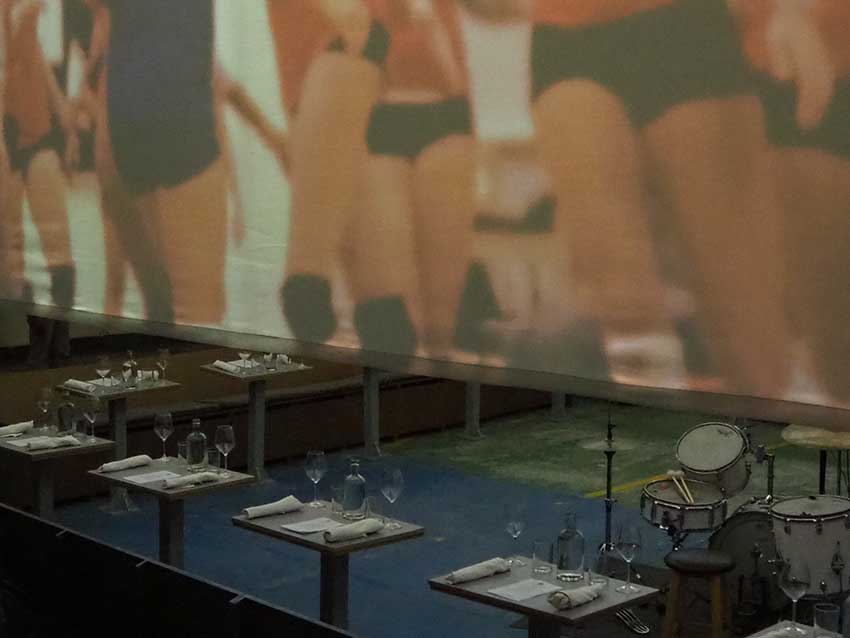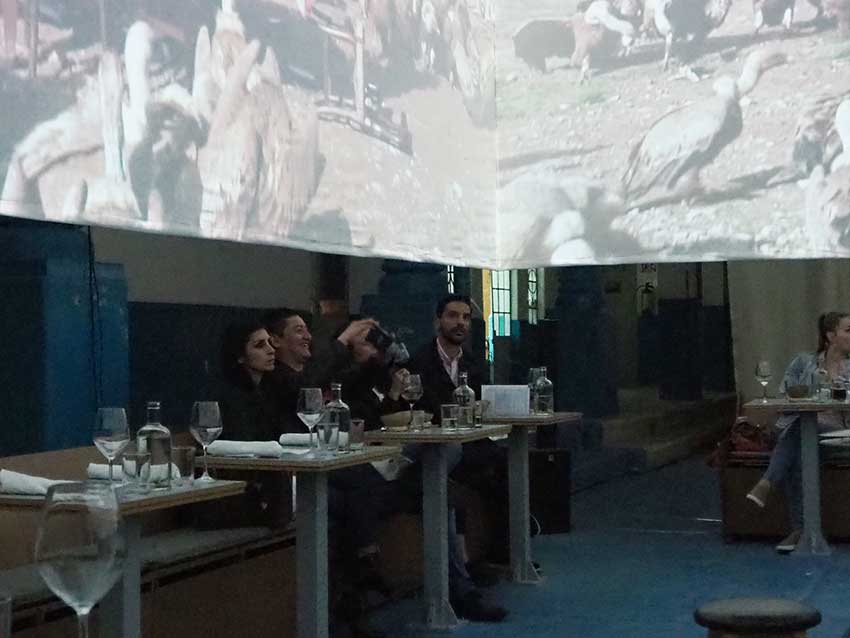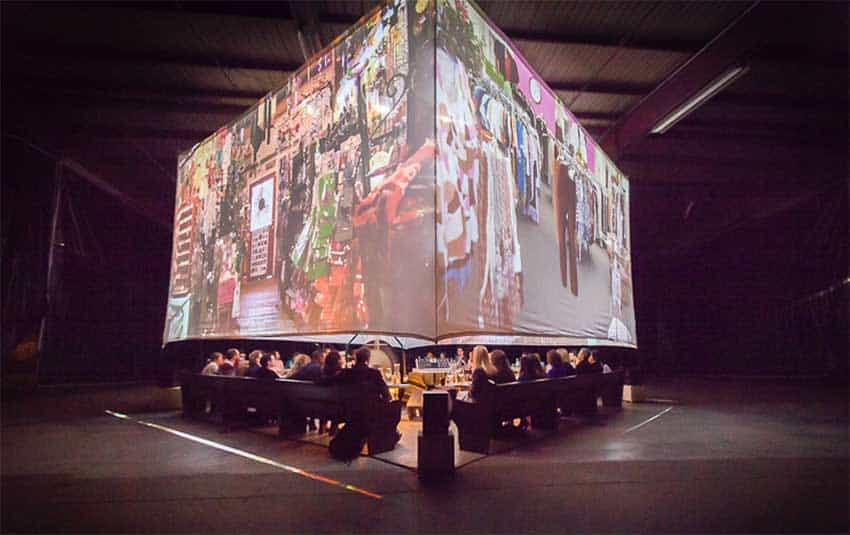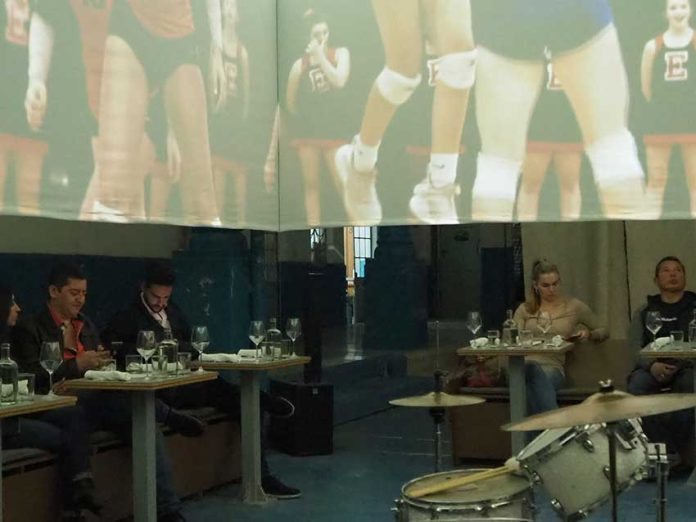Step into the 27-foot multimedia cube at Colegio Dante Alighieri Catholic school in Mexico City for a sensory experience unlike anything else – a five-course custom culinary creation from one of Mexico’s most beloved chefs, Jaír Téllez of MeroToro and AMAYA, and a two-hour program of film and performance from the legendary experimental cinema project, Monkey Town.
Comfy benches line the gymnasium at the school, located in Colonia Escandón, each situated under one of the four projection screens. Diners sit at small tables for two, literally surrounded by cinema, featuring works by 18 filmmakers and artists from Mexico, Latin America, Europe, Russia, and the United States.
The subject matter runs from straightforward narrative to contemplative visual poetry and sharp political commentary.
The vastly different films become bound together by the experience that’s like watching from inside the film, inducing a sort of mild psychedelia that’s only intensified by the warm belly glow of wine and tequila. The four screens and multi-speaker surround sound hold the viewer, as if in a closed chamber, while from above:
A post-apocalyptic neon wolfman speeds along on a glowing motor scooter, smoking mechanical amphetamine, out to settle a score.

A stampede of rolling mangos leaps from tin roof to tin roof, echoing like an off-kilter drum corps, building in speed and sound.
A woman searches for enlightenment on a web browser and enters a dream world of New Age product placement spirituality.
Cruise ship passengers are injured by games of leisure. A snorkeler is sucked into ocean oblivion, and a single golf ball prevails.
This marks the 16th year and eighth edition of Monkey Town, which originally began in New York City and has run in Denver, Barcelona, Austin and Los Angeles.
Monkey Town founder and director Montgomery Knott first conceived of the program after seeing a four-channel Christian Marklay video work and sketched a crude drawing of the idea on a cocktail napkin. Eight months later Monkey Town was born and other artists soon began making works for the program.
Of the Mexico City version Knott explains, “About half of the artists made or adapted pieces specifically for the cube. I normally try to have a mix where we switch between single, two-channel and four-channel pieces. I asked friends, curators and artists from Mexico City. And they asked two friends and they asked two friends and so on and so on. Mostly a game of phone, linking up with people and trying to curate a diverse program, with a variety of aesthetics. It’s a survey of contemporary video art, without trying to be thematic or zeitgeisty.”

On the food side of the program, the menu is quintessential Chef Téllez – classic Mexican ingredients with masterful French training and Mediterranean aesthetics: sea scallop with parsnip, xoconostle cactus fruit and lime; fresh corn tamal with roasted hen broth and quail egg; and grilled sea bass in escabeche with salt-cured nopales.
The minimal service allows for little distraction from food and film. Talking is certainly allowed but appreciated in hushed tones – the dining experience heightened as ingredients obscure and then materialize into view under the shimmer and glow of projected movement.
Both Chef Téllez’s restaurants MeroToro and Laja have appeared on Latin America’s best 50 restaurants list. His third restaurant, AMAYA, has become a Mexico City institution in recent years for its world-class, fresh and rustic, Baja-Mediterranean plates and one of the best natural wine lists in the country.
Téllez admits that he’d never heard of Monkey Town before his introduction to Knott but immediately liked the idea, and says, “it was quite easy to decide and collaborate with him.” While envisioning a menu for Monkey Town, Téllez says he sought to create “food that is expressive and delicious, yet a meal that flows with the experience and doesn’t protagonize.”
Knott continues, “We were talking to a few chefs, but once we met with Chef Téllez we knew we’d found our compatriot. His cuisine manages to be both exquisite and unpretentious. There’s so much thought behind each dish, but it’s not trying to be showy. I think there’s an affinity with our program in this process and effect.”
In addition to the film schedule, which will be consistent throughout the four-month run, each night will feature a changing catalog of live performers, including dance, opera, chamber music and a variety of experimental music and performance art.

A recent performance from multi-instrumentalist Paz Lenchantin of The Pixies, accompanied by Tennessee Thomas on drums, had the two performers “on stage” surrounded by the screens, as Lenchantin’s film The Spider Lady – a black and white, stop motion ode to 40s-era horror and avant-garde – danced images across them.
Lenchantin’s live-looped droning tones and Thomas’s slow gallop of drums induced a trance, echoing throughout the concrete and formica gymnasium, as the spider woman stalked her prey, the theremin’s hypnotic wail providing the perfect creepy backdrop to the film.
Monkey Town runs Mondays through Saturdays until May 31 at Cda. La Paz 15, Colonia Escandón. Purchase tickets in advance from Monkey Town’s website: 800-1,200 pesos for four to five-course meals, with two nightly seatings.
